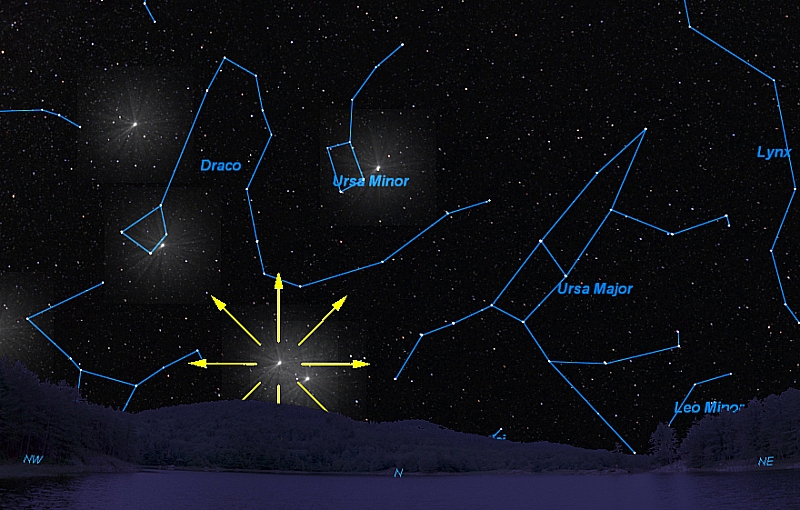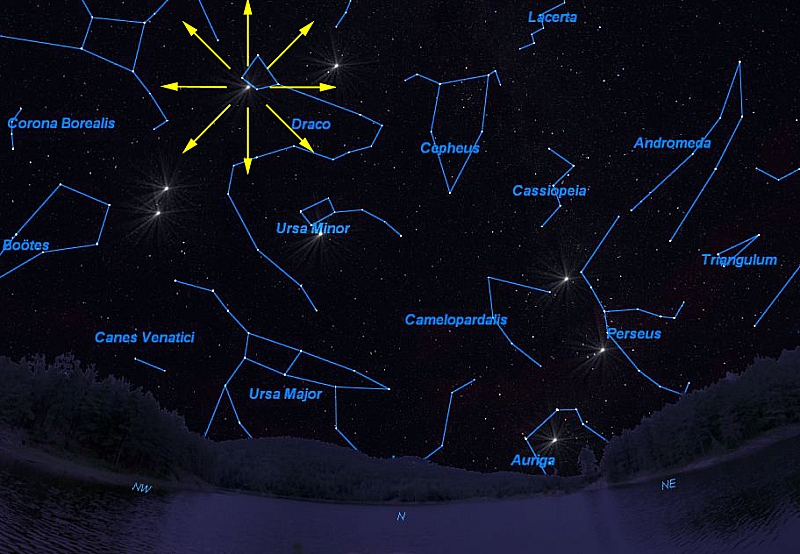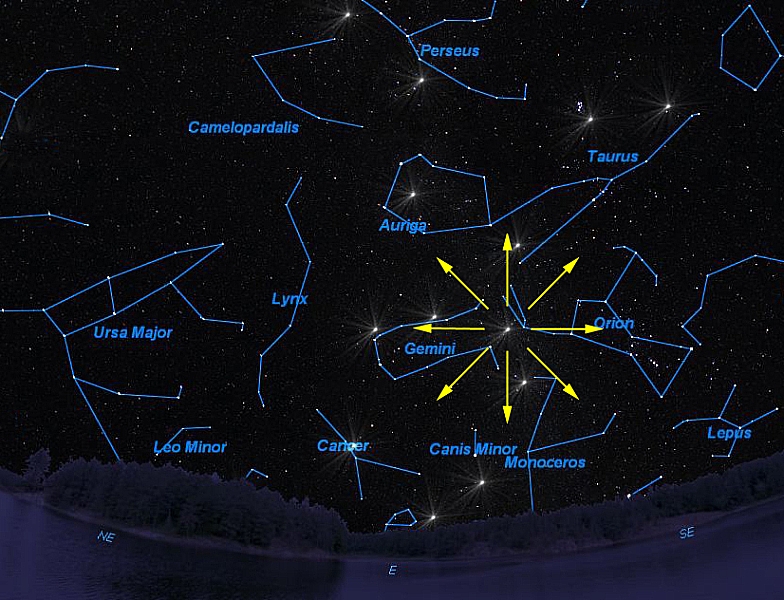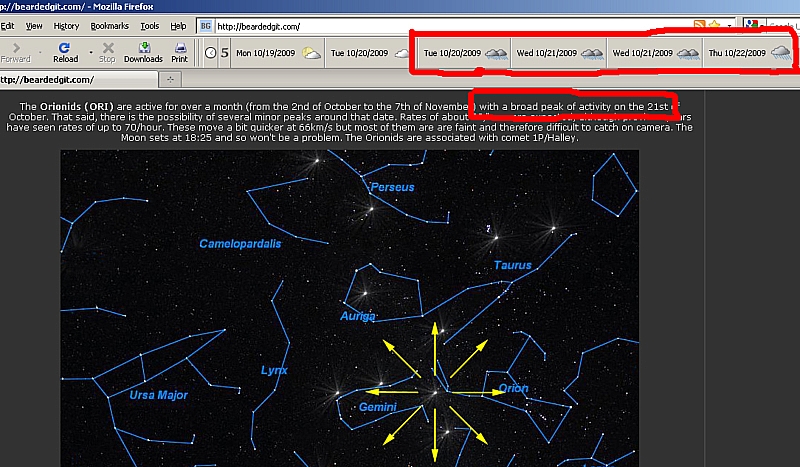Some timely information for those intending to go out to see the impending Perseid meteor shower:
Posts tagged 'meteors'
Observing Report 17th-18th November 2012 (Part 1 – in like a lion, out like a… bull)
I spent ages outside in the freezing cold last night trying to catch some Leonid (LEO) meteors on camera. There were quite a few about and I was pointing the camera in the right direction, but after taking 443 30-second exposures I'd not managed to get one in shot.
I did, however, manage to snap this little beauty racing eastward between Auriga and Cassiopeia - it's a Taurid, probably a Northern Taurid (NTA):
I'm quite pleased with that result, and the whole exercise was good practice for next month's Geminids (GEM).
Observing Report 3rd January 2010 (Quads workout)
After having had the weather spoil most of the meteor events of 2009 I was hopeful that the clear skies of the current cold spell would permit a reasonable view of the 2010 Quadrantids. Late in the afternoon the skies darkened and the clarity was good, so I prepped for a 2-hour session to start at 18:00.
The view northwards from the top of our plot is reasonable, looking out across dark gardens and a large low retirement-home. The radiant was just visible above the artificial horizon, so there was a fair chance that I'd be able to see most of the upper 180-degree arc of the display. Doing some rough maths I figured that if the peak rate was 120/hour I'd get a reduction of 50% due to the 180-degree restriction and a further 50% reduction due to the low elevation. If all went well, I'd be looking for 30 meteors during the 18:30 - 19:30 peak hour.
18:00 arrived and I set up the camera. Despite having taken it outside early to acclimatize, the internal optics hazed up within minutes due to the low temperature (-4C and falling) so pics were a no-no. I've an aversion to forcing heat into any camera, so I took it back indoors for a gentle rewarm and resigned myself to a visual-only session. I found myself a comfy place from where to watch.
As the minutes passed the horizon became a hazy yellow mess due to a combination of a thin fog and light-pollution from the local street-lights and from the retirement home. Seeing 30 meteors in the next hour was going to be a challenge.
The show started at 18:46 - a trail straight through the head of Draco. And another a minute later, this time up near Cepheus. Things were looking good, but then it stopped. I saw only one more trail - a gloriously-bright streak almost overhead, passing through Cassiopeia at about 19:20.
In summary, the show wasn't much of a success, but it was good to be out again, despite the biting cold.
The next half-decent show should be the Lyrids in April, active from the 16th to the 25th with peak activity on the 22nd. Hopefully there'll be better conditions allowing me to get some pics as well as views.
Slow start
The first quarter of the year is always poor for meteor viewing, there being only one major shower. Fair enough, there are a few minor showers in the first three months, but they hardly ever amount to much, which makes this post short and sweet...
The Quadrantids (QUA) are going to be peaking at around 19:00 on the 3rd of January, but seeing them isn't going to be easy as the waning Moon will be ruining the show. If you do get clear skies and the urge to observe, expect rates of 120/hour with the possibility of some variation between 60 and 200/hour. Speedwise we're looking at 41km/s. The Quadrantids are probably associated with minor planet 2003 EH1 (= comet C/1490 Y1?).

The Quadrantid radiant
There, that was easy. If you're going out to see them, good luck!
Grand Finale
The last quarter of the year promises to be good for meteor viewing. Most of the major showers coincide with favourable Moon phases, so the chances of dark skies are fairly high. For those with an interest in such things, here's a quick "what, when and where" for the rest of the year, based on several info sources:
The Draconids (DRA) will be on show from the 6th to the 10th of October, with peak activity on the 8th at 16:40, and the possibility of some other minor peaks. Expect variable rates, previous storm rates have been up to 500/hour. They're slow-moving things at 20km/s, so they should be easy to identify. The waning Moon rises at 19:18, so there's some time to see what's about before things get too bright. The Draconids are associated with comet 21P/Giacobini-Zinner.

The Draconid radiant
The Orionids (ORI) are active for over a month (from the 2nd of October to the 7th of November) with a broad peak of activity on the 21st of October. That said, there is the possibility of several minor peaks around that date. Rates of about 30/hour are expected, although previous years have seen rates of up to 70/hour. These move a bit quicker at 66km/s but most of them are are faint and therefore difficult to catch on camera. The Moon sets at 18:25 and so won't be a problem. The Orionids are associated with comet 1P/Halley.

The Orionid radiant
The Leonids (LEO) are on the go from the 10th to the 21st of November, with several peaks expected around the major one at 15:10 on the 17th. Rates for this shower are high (>100/hour) with some researchers predicting brief periods with storm rates of >1000/hour, so this is one to watch, especially with there being no moonlight to contend with! With a speed of 71km/s these are the fastest meteors and they produce long, bright and often colourful trails which are easy to catch on camera. The Leonids are associated with comet 55P/Tempel-Tuttle.

The Leonid radiant
The Alpha-Monocerotids (AMO) could be good this year. The shower lasts from the 15th to the 25th of November with peak activity on the 21st at 15:25. Rates are usually poor at only <10/hour, but short-duration storm-rates of >400/hour have been observed. AMO meteors speed along at 65km/s. The Moon sets at 19:48 and so won't be a problem late on, but could be a hindrance before that.

The Alpha-Monocerotid radiant
The Geminids (GEM) are active between the 7th and the 17th of December, peaking on the 14th at 05:10. Peak rates are generally high and reliable at 120/hour, and the meteors are bright and slow at 35km/s, producing fireballs with bright colours. Ever reliable, this is another event not to be missed. Again, there's no moonlight to spoil the show. The Geminids are associated with asteroid 3200 Phaethon.

The Geminid radiant
The Ursids (URS) will be on show from the 17th to the 29th of December. They are at max on the 22nd with peak rates of only 10/hour, although rates of up to 50/hour have been noted. Speeds are low at 33km/s and the meteors are faint. The Moon sets at 22:14 and so will need to be worked around, assuming that you're not too busy wrapping pressies, visiting relations or getting smashed at the office party. The Ursids are associated with comet 8P/Tuttle.

The Ursid radiant
E. & O. E.
---oooOOOooo---
I should point out that I've only covered the best few meteor events that are visible from the top half of the world. For a full list, you should refer to the IMO Working List of Visual Meteor Showers.
---oooOOOooo---
If you're going out to observe these things, the standard common-sense rules apply. I've stated some guidelines elsewhere on this blog, but there's no harm in posting a revised set here:
- Get the map out and find a suitable site. Ideally there will be full 360-degree visibility and no light-pollution anywhere, but that's not going to happen here in Blighty unless you're very lucky. Try to find somewhere where you can see a good portion of the area around the radiant in front of you, and with any sources of light-pollution behind you. Open spaces are good, but they tend to be short on shelter and so you'll catch whatever wind there is. This year I'll be taking a tarp for that extra bit of luxury.
- To stay warm, you’ll need to be properly insulated. Wear plenty of warm layers and take some spares, it gets damned cold and often damp at night this time of the year if you’re in this neck of the woods (52 degrees North). Fur-lined boots are brilliant if it’s frosty, and if you’re mad like me, sticking your booted feet in a cardboard box can keep a breeze off your feet as well as providing insulation from the ground. A comfy chair’s great for sitting, but I’ve managed to get myself frozen to mine a few times so be careful when you stand up after a long frosty rest, you’ll feel like an eejut walking around with a deckchair stuck on your back.
- I would advise taking hot drinks, or a means to make them (I take the Jetboil and supplies so that I can enjoy the luxury of a fresh cuppa). If you’re partial to snacks, be aware that things like chocolate will melt in your pocket, or freeze to the consistency of a dinner-plate if you leave then out in the cold.
- As for camera settings, well, aperture is everything, just shoot wide-open, in RAW format if possible. There’s no point in going for long exposures if the target is only in the field of view for a second or so. Besides, longer exposures mean longer star-trails, unless you’re using a tracking mount. Go for a wider lens rather than a tele, so that you can frame a familiar area of the sky. A tripod is more-or-less mandatory, and a remote release is more useful than using a self-timer. Keep an eye on the effect that the cold is having on your camera, demisting and defrosting tends to be needed more often than you think, and condensation on the inner elements of the optics can be a pain to deal with. Remember that the cold can significantly reduce the efficiency of the camera's battery, so keep spares in a warm pocket. One useful tip – manually focus your lens on infinity and paint a couple of alignment marks on it before you go out into the dark. Better still, when the lens is correctly set (and on "manual") then apply some gaffer-tape to it to keep the focusing-ring in the desired place. Focusing in the dark can be a nightmare, especially with autofocus lenses that focus beyond infinity. As for framing the shot, it's not a bad idea to have a well-known constellation in there so as folk can use it as a reference. Including a bit of horizon can lend some perspective to what would otherwise turn out to be a dark frame with a few white dots and dashes.
- Other useful kit: Starchart/planisphere, mobile phone, torch with red filter, spare batteries in you pocket, binoculars, kitchen sink...
- One last thing: If you’re dependent on your car, FFS keep your de-icer with you. It’s no fun being frozen out of your car so early in the morning with a long walk home through the snow while carrying your gear. It’s even worse when you can see the de-icer through the frozen window, just lying there taking the p155 out of you.
Have fun!






